Task Management in Slack: 3 Ways You Can Do It
Can Slack handle task management? Yes! In this post, we’ll show you three common ways and dive deep into each method.


If Slack is your go-to communication tool, you might want to use it for task management. Slack can be powerful when used for prioritizing, assigning, and managing your day-to-day tasks.
But when it comes to task management, people often need a dedicated task management tool. Usually, this is because they don’t have an outlined task management process that they can execute in Slack.
So, can you actually do task management in Slack? You can, but setting the proper foundation takes a little work. There are multiple ways to manage tasks in Slack. In this post, we’ll show you three common approaches and dive deep into each method. We’ll also show you how you can automate tasks with a powerful Slack add-on.
How Slack Can Be Used for Task Management
Slack does not provide dedicated task management capabilities. However, there are ways you can adapt Slack's capabilities to manage your tasks with Slack messages and Slack posts. Many add-on tools can turn Slack into a powerhouse for task management and workflow automation, but for now, let’s focus on using Slack alone. Later, we’ll show you a better way to automatically manage tasks and approvals in Slack.
Create a Dedicated Task Management Channel in Slack
We’ll start by saying that this first method is only a good idea if you’re a small team. It’s not automated, so think of this as a hack.
First, create a separate Slack channel for managing tasks. Channels in Slack help you segregate data and communication. Why bother your entire company when your point of contact for task management is only the engineering team?
I'll walk you through how to create a channel called 'tasks' in your Slack workspace. You can assume this channel will hold all communication regarding task management. In a real-life use case, having a single Slack channel for managing tasks can help you avoid communication overhead, and it works well for small and compact teams.
If you’re working for a large organization, you can create separate channels for task management for different teams and departments. For example, you can have a channel called tasks-product for managing tasks for the entire product team. Or you could have a channel called tasks-payments for managing all the tasks for members of the payments team.
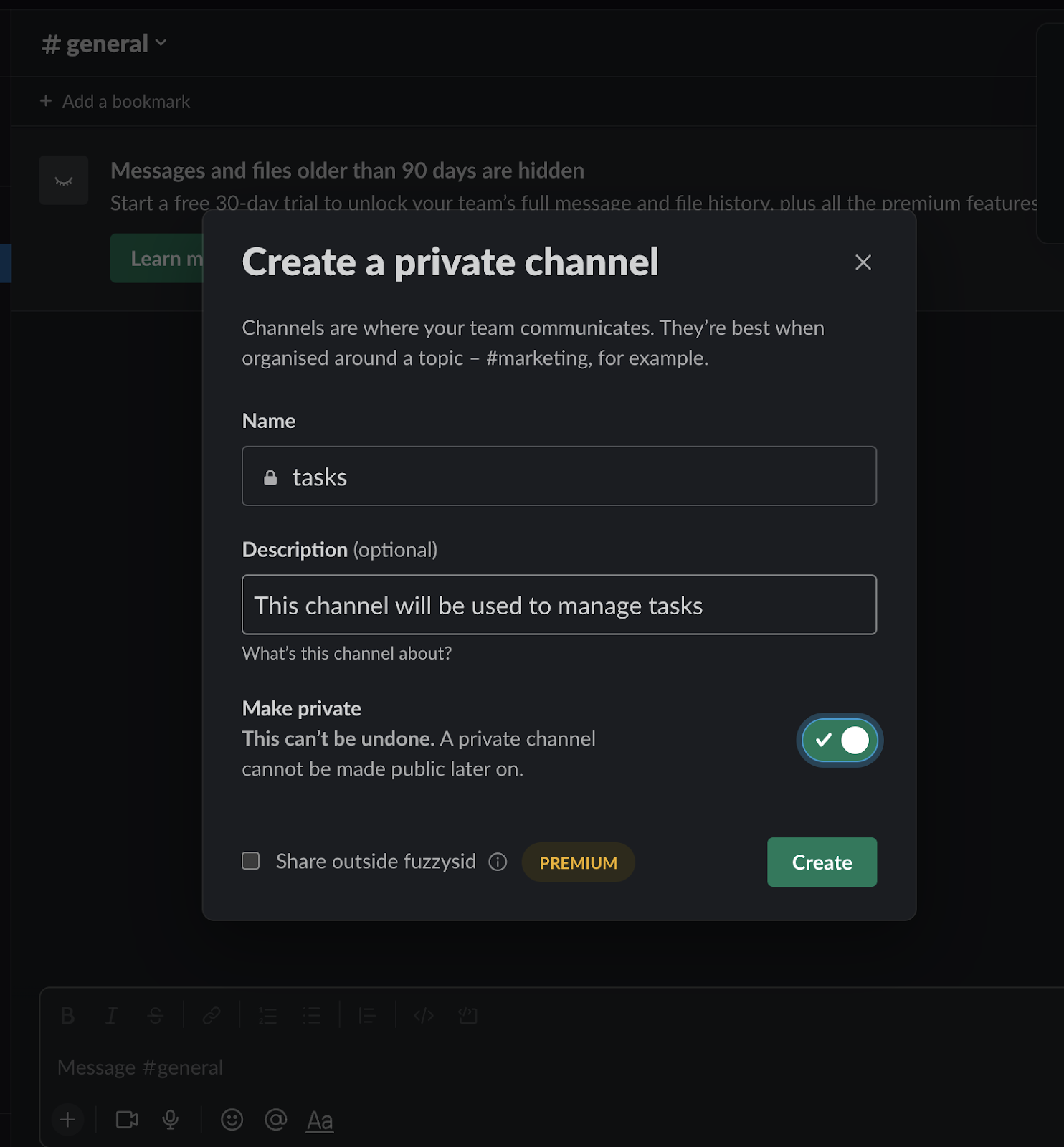
This is where you'll handle everything internally for task management in your Slack workspace.
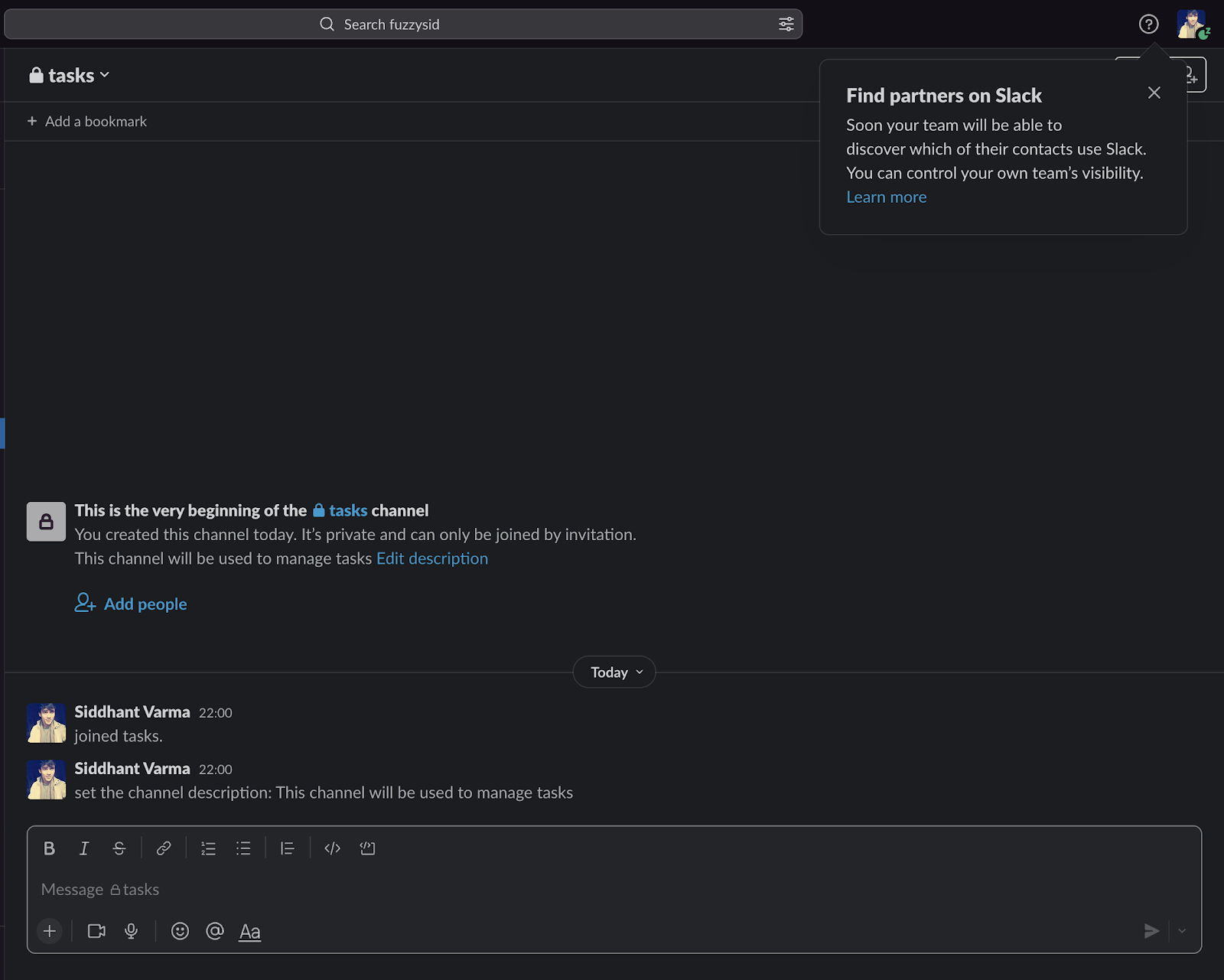
Task Management Using Slack Messages
If you're a Slack user, you've probably already unknowingly used it to manage some of your tasks. Messaging in Slack isn't limited to a simple text message. You get a built-in mini-rich text editor inside your Slack messages while drafting them.

Notice that it has options for adding ordered and unordered lists. You can use these list types to list your tasks.
Set Up Tasks in Slack Using Slack Messages
Let's look at the entire workflow. You've already created a dedicated channel called 'tasks' for task management in your workspace. Next, you'll want to add all the team members you wish to be a part of the task management workflow.
You can create a list using Slack messages for each sprint or task workflow. Then tag each member in each task in the list to assign them that task. Once members complete a task they're tagged in, they can comment or react to that message. From here, you can use Slack notifications to track these changes and update the task list.
Let's now look at each action item in this workflow with an example.
Creating a Task List
First, create a simple task list using Slack's message text editor. Notice that you can be creative. You can specify you are the author of the task list and at what time it was created. You can mention the topic of the task list. Finally, you can use a combination of ordered and unordered lists to create the task list. Each task is a list item in an ordered list. Some tasks may have subtasks. So, each subtask pertains to a list item in the unordered list.

Assigning Tasks
Next, assign these task items to various members. Simply tag them against each of their task items. After you tag each member, Slack will notify them when you post this message on the 'tasks' channel as shown below:

Perform Various Processes for Task Management
Your task list is out! Designated members have also been assigned. Notice the first task is assigned to me. When I’ve completed my task, I can edit the message and strikethrough the first item:

So, I’ve marked my task as completed. But wait, other members can't do that because they can't edit the message since I drafted the message. So, what can they do?
They can comment on the message, initiating a new Slack thread. Team members can indicate that they've completed the task in this thread. The time of their message on the thread will indicate when the task was completed. Not an ideal method, but it works in a pinch.
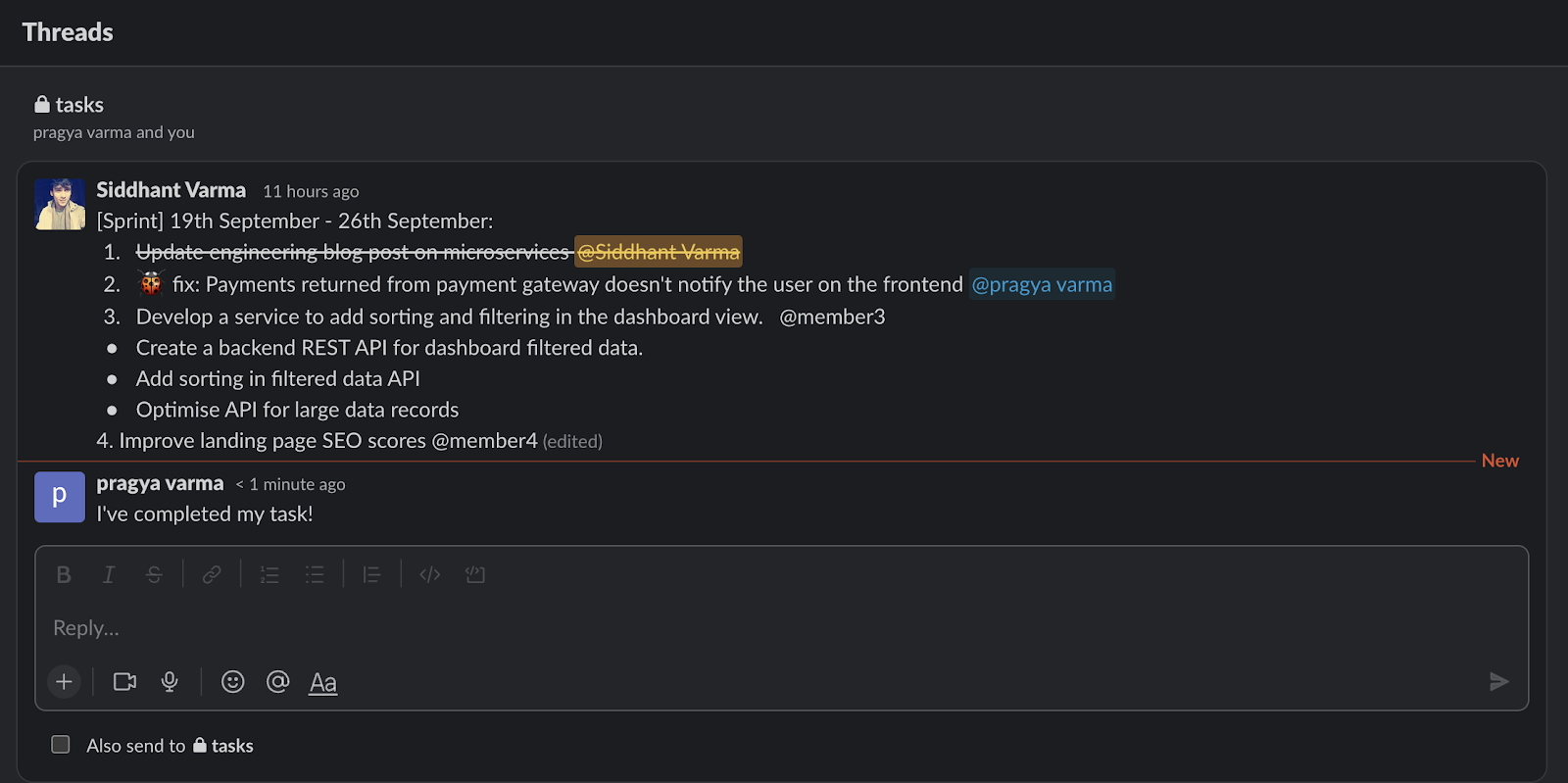
Tracking Tasks
Whenever someone comments on the task message thread, Slack will notify you.
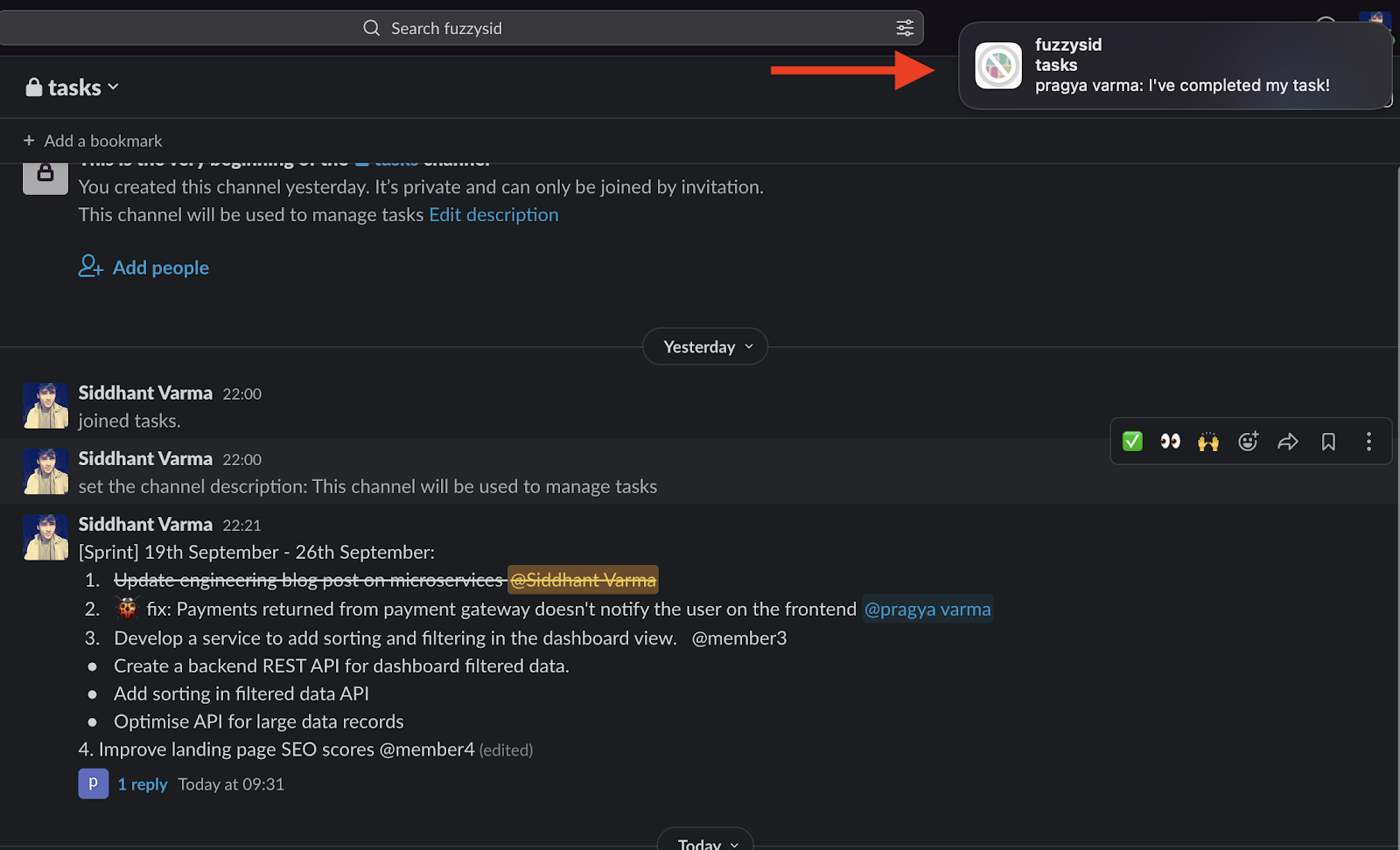
Hopefully, you've been following that thread since you drafted the message, and by monitoring, you’ll be able to track your tasks.

Now whenever any member comments or reacts on this thread, Slack will notify you of that change. You can then edit the message to mark a task as completed:

Drawbacks
You've leveraged Slack's communication capabilities to create, assign, track, and update tasks. However, there are several drawbacks to this approach. First, your members can't directly edit the message, which means you rely on them to message you in the thread whenever they’ve completed a task. Second, when they message, you must go back to your original message and strike through the tasks they completed. As you can see, this gets messy.
Let's look at the second method of managing tasks in Slack that eliminates this drawback using Slack posts.
Task Management Using Slack Posts
Slack posts are just like Slack messages, but they allow for a more collaborative approach to drafting messages. You can create a new Slack post where you'll jot down the list of tasks and share them in the tasks channel. Since it's a post and not a regular Slack message, you can enable others to edit this post, allowing them to mark their tasks as completed. Let's look at each step in this process
Set Up Tasks in Slack Using Slack Posts
Inside the tasks channel, click on the plus icon that pops in the bottom-left corner of the message box. This should open a dropdown menu with an option to create a new post:
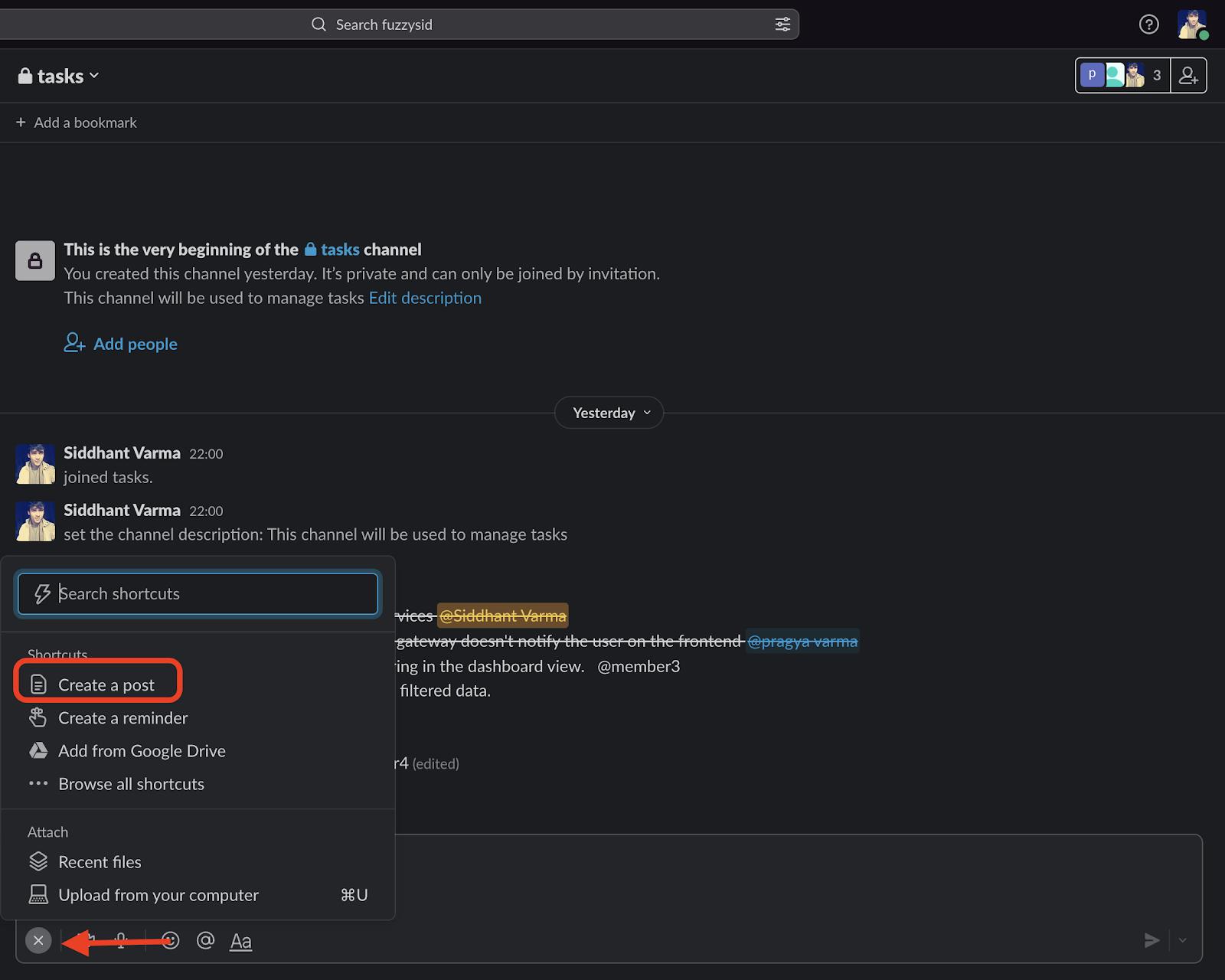
That will open a fresh new Slack post screen:
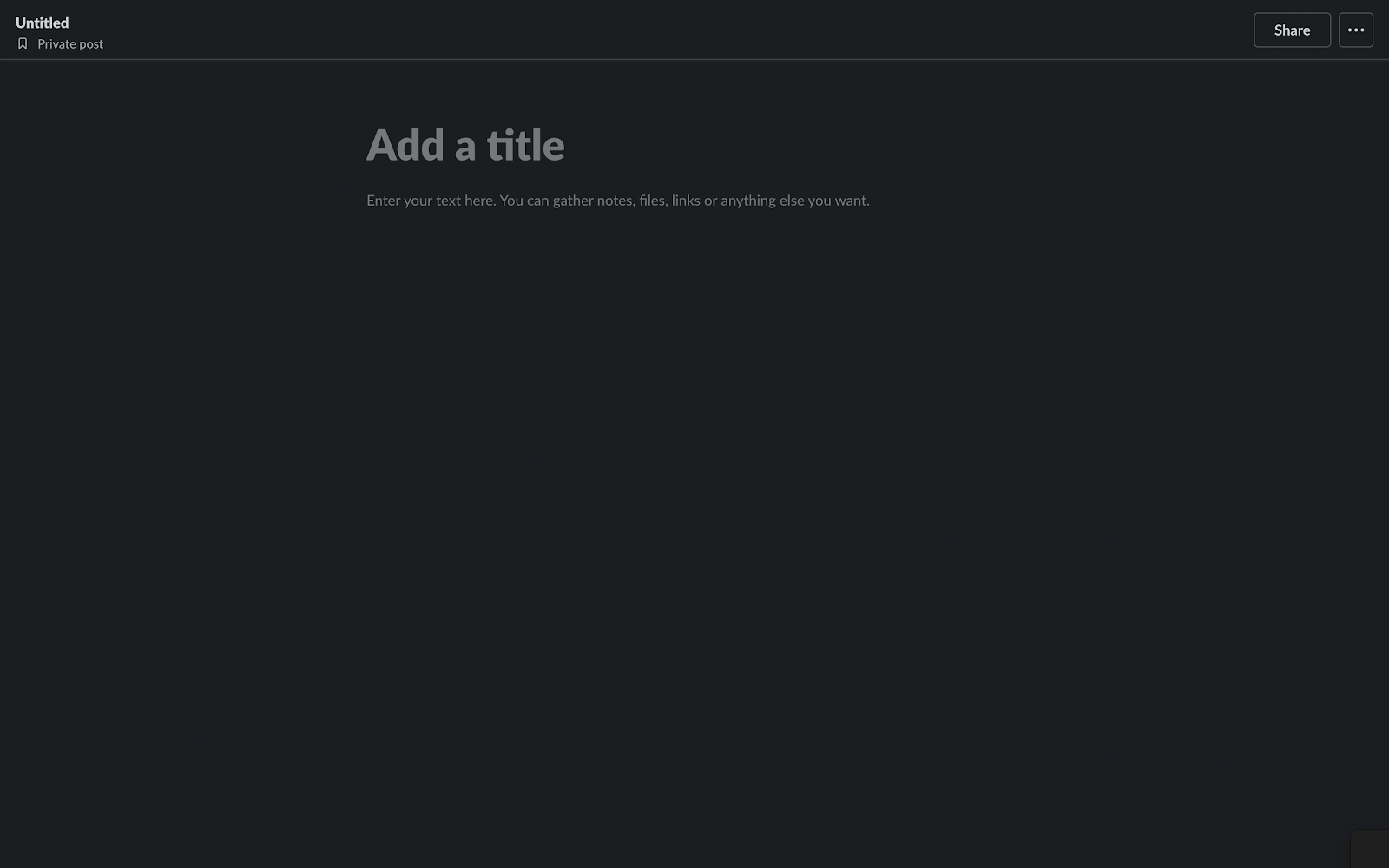
Creating a Task List
Slack posts may not be as intuitive to draft since the text editor toolbar doesn't appear by default. However, you can see the keyboard shortcuts quite easily on this page.

I titled this post with the name of my task list. Once you open keyboard shortcuts, you can choose the checklist keyboard shortcut. Let's take the previous task list and convert it into a checklist here:

Assigning Tasks
In order to assign each item in the checklist as a task to a member, you'll need to specify the person's name. You can't tag a person against each checklist because it's a Slack post and not a message. You can also minify the checklist while assigning tasks to your team members:

Share Post
The final step is to share the post on the tasks channel. In the top-right corner, click the Share button:
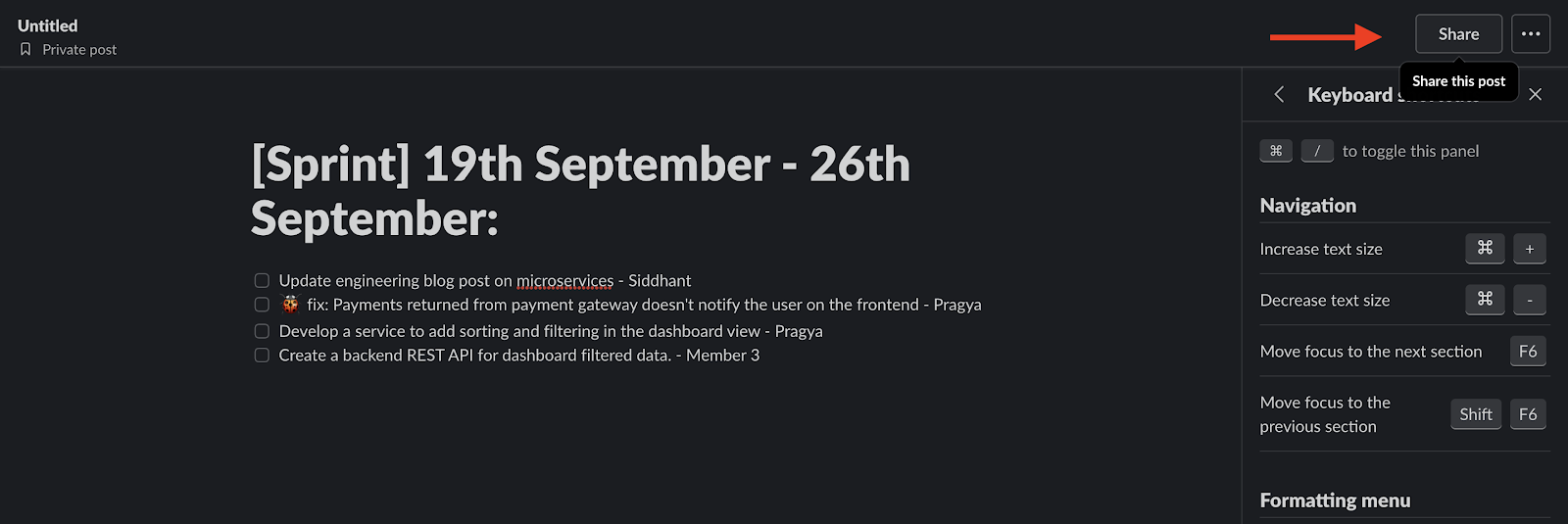
That will open the Share settings dropdown. The channel for your post to be shared should be auto-selected, but if not, you can choose the channel you want to share in. Make sure you check the "Let others edit this post" box. This is the most important part of the workflow. It will allow others to edit the post and make changes to it. You can also add any additional comments to be shared with the post. Then click the Share button:
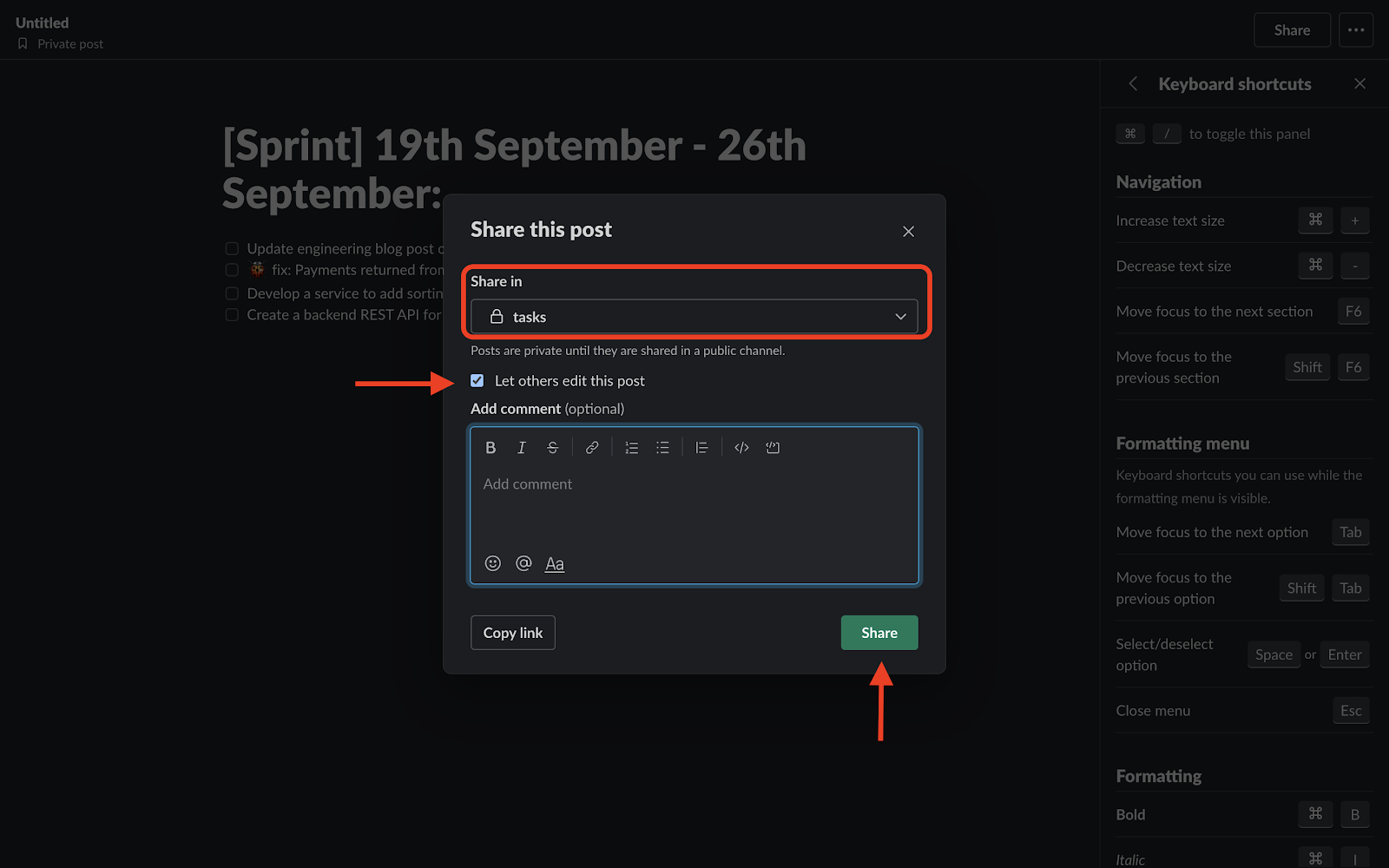
And voila! Your post will be shared on the 'tasks' channel:

Tracking and Completing Tasks
Any member can now open this Slack post and mark a checklist item as done when they're finished.

And once they do that, the task list will be automatically updated on its own:

This is more convenient than the earlier methodology. Here, users or members can mark the task items as completed. Additionally, they can leave comments on the thread so that Slack sends the admin a notification that can help with tracking tasks statuses more effectively. But again, this can get messy fast and difficult to scale as your team grows. Also, since they can’t be tagged, it’s easy for work to get lost.
Common Drawbacks of Slack Posts and Messages
Both of these methods are limited in what they offer for task management. The process is not visually intuitive, nor is it convenient to use across various teams, departments, and domains. For a more refined task management workflow, Slack offers third-party app integrations, which can bring automation into your Slack workspace. This is where a tool like Wrangle comes into play.
Use Wrangle for Task Management in Slack
Now we'll cover the third method of managing tasks in Slack using a tool called Wrangle to create task management workflows conveniently. Wrangle is a workflow automation tool built for Slack, and you can try it for free.Visit Wrangle.io and click the "Add to Slack" button:

Wrangle will ask you to add its app to your Slack workspace:

Now, you can create a task list using Wrangle. We’ll start with a quick task list. Click the “Create Task List” button.

Here, you can enter the name of the task list, select the channel to which it should be added, and type in the task name. Then you can simply assign this task to anyone in your Slack workspace:

You can also assign it to more than one person at a time. I'm going to assign this task to myself:
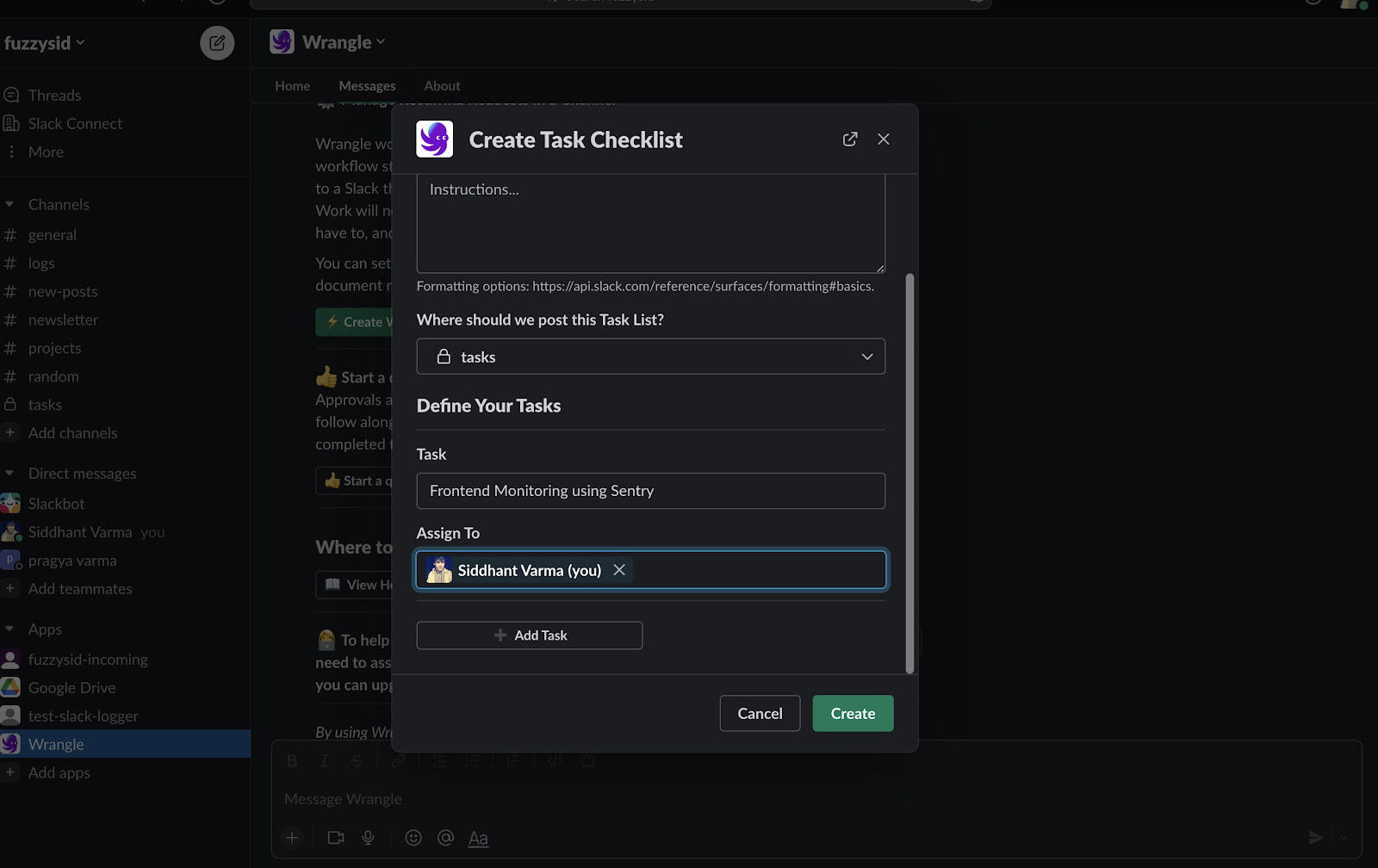
Wrangle will send the assignee a notification, and you can see it’s automatically posted in the 'tasks' channel:
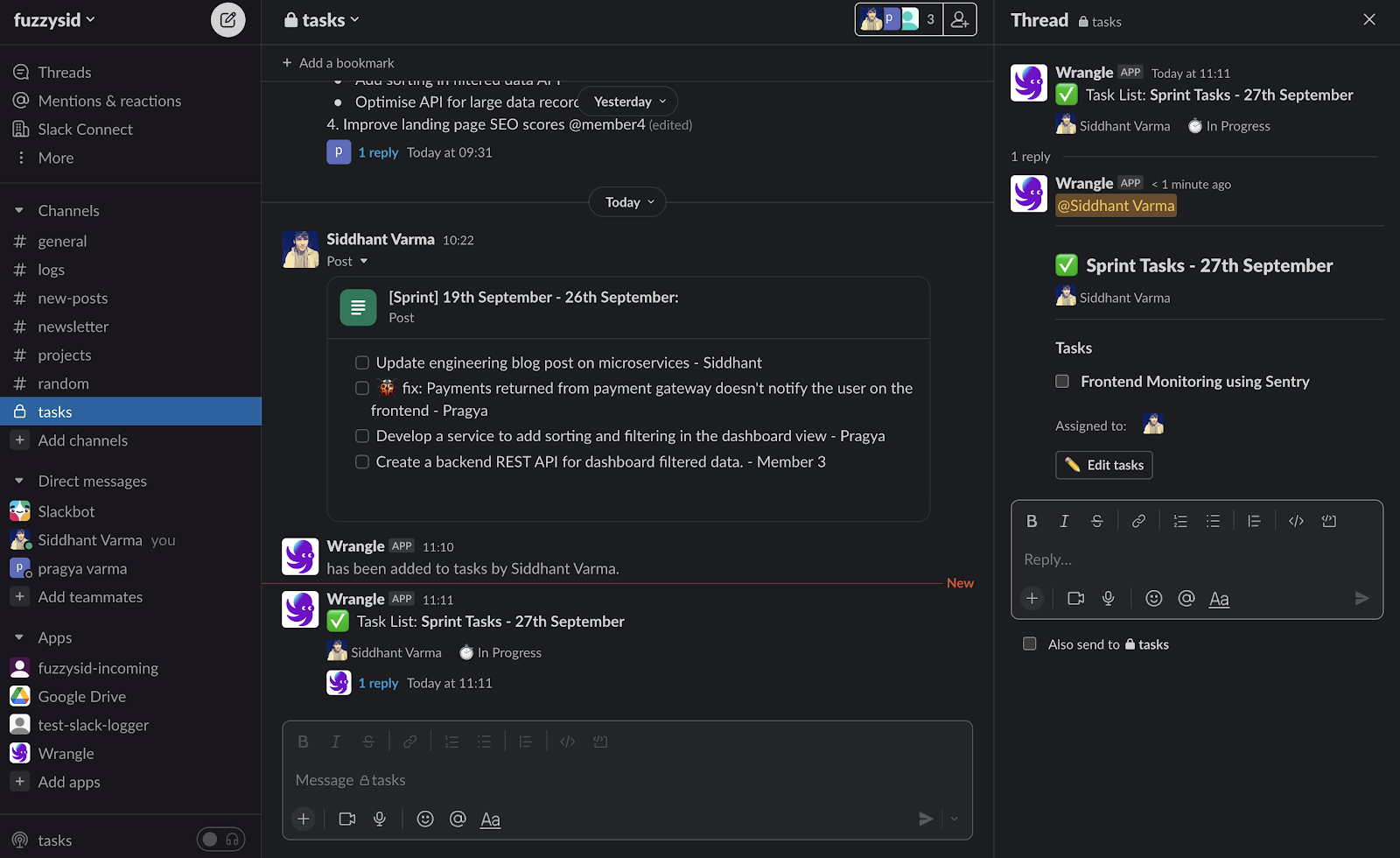
You can see the task list, the exact information and details of a task, and perform various actions like marking them as completed. Let's mark my task as completed:

Wrangle immediately updates the task list and sends you a notification! This approach is visually intuitive, easy to set up, and requires minimal manual communication to manage tasks. In addition, by going to the task dashboard, Wrangle gives you a centralized place to view all of your tasks.

Start automating your tasks list with powerful workflows
Many of our everyday tasks are repeatable processes. This is where workflow automation can come in handy. Wrangle can turn task lists into automated workflows accessible in your Slack channels. Let’s take a look at another example.
Any task list can be automated, but we’ll illustrate with an IT example. Perhaps you work as an IT manager, and you’re assigned to the help desk. When an issue is received, a manager will triage the ticket and assign it to the right individual. The process of manually triaging and assigning tasks in a Slack channel is daunting. A Wrangle workflow allows you to manage tickets and tasks inside Slack, but with pre-built workflows that automatically assign the issue based on conditional steps.
As an IT manager, you might have a long list of issues, but they’re probably categorized into buckets. Let’s assume you frequently deal with:
- Access Requests
- Internet Outage
- Printing
- Hardware Issues
You can build a Wrangle workflow that your users can access in Slack to report issues or make requests. Your agents can manage the tickets in Slack or in the Wrangle web application. Let’s look at how you might build this simple workflow to manage your frequent IT task lists.
Wrangle is accessed in Slack, but their web application is where you’ll go to design workflows. First, visit Wrangle.io, and if you have an account, click log in. If not, install the add-on by clicking “Add to Slack.” You’ll be directed to the web application during the sign-up process. Once you’re in, click “Create Workflow.”

Wrangle will direct you to a template gallery. We have lots of templates for all kinds of departments. You’ll notice we even have one for the IT help desk. You can select a template or start with a blank workflow. We’ll choose the help desk template and adapt it to work for our company.

Now, we’re ready to build our workflow so we can automate our IT tasks in Slack. We’ve created a workflow with several steps to handle each issue. We used conditional steps so that each category of issue creates a ticket that is automatically assigned to the right agent.

The intake form we’ve created sets the stage for our workflow. In this case, this will be the first stage of an IT ticketing process that creates task lists for each category of work. We’ve created a list of options your end users can choose from. This form will be accessible in Slack, meaning your users never need to log in to a separate system to make a request. We’ve created a step for each ticket type in our list question: 1)Hardware Service 2) Printing 3) Internet outage 4) Access request. Let’s look at a step for one of our issues.

You’ll recall in the intake form that one of our work categories is assigning tickets related to an internet outage. Above, we’ve created a conditional step for that issue with a series of tasks. An office internet outage is a big deal! This ticket will automatically post to the IT-help-desk Slack channel, and we’ve assigned this category of tickets to Beverly because she has the relationship with our internet provider. We used the conditional step to ensure all of these get routed directly to Beverly, but everyone will be able to see this issue reported in the Slack channel. We created two tasks that we know we’ll want to complete 1) confirm the outage and 2) contact the internet service provider. Now that we’ve built and published this workflow let’s see what this looks like in action in our Slack workspace.
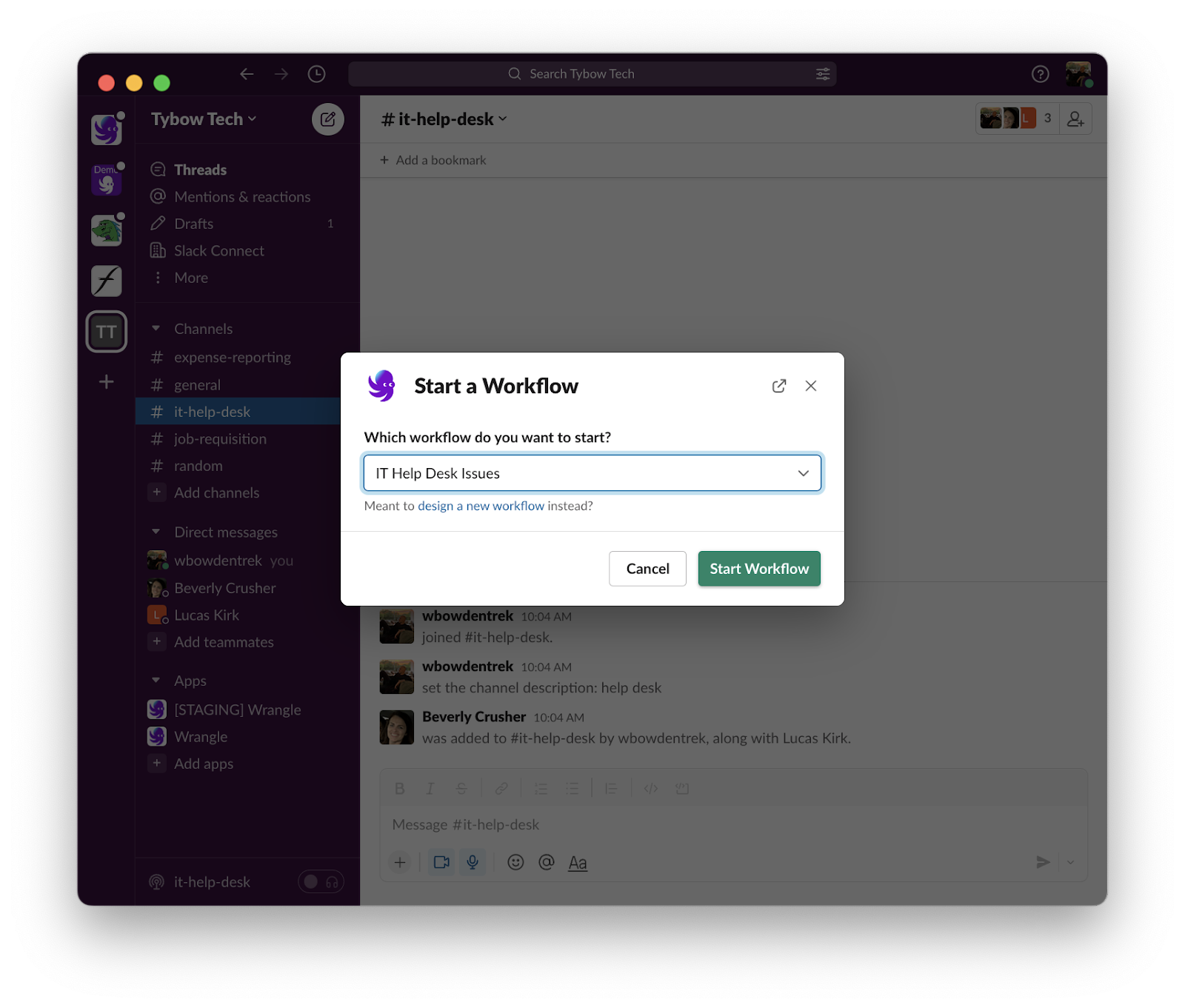
When we published our workflow, it was automatically available in Slack. Here, one of our employees will report an outage, which will set up the task lists we built in the Wrangle web application.
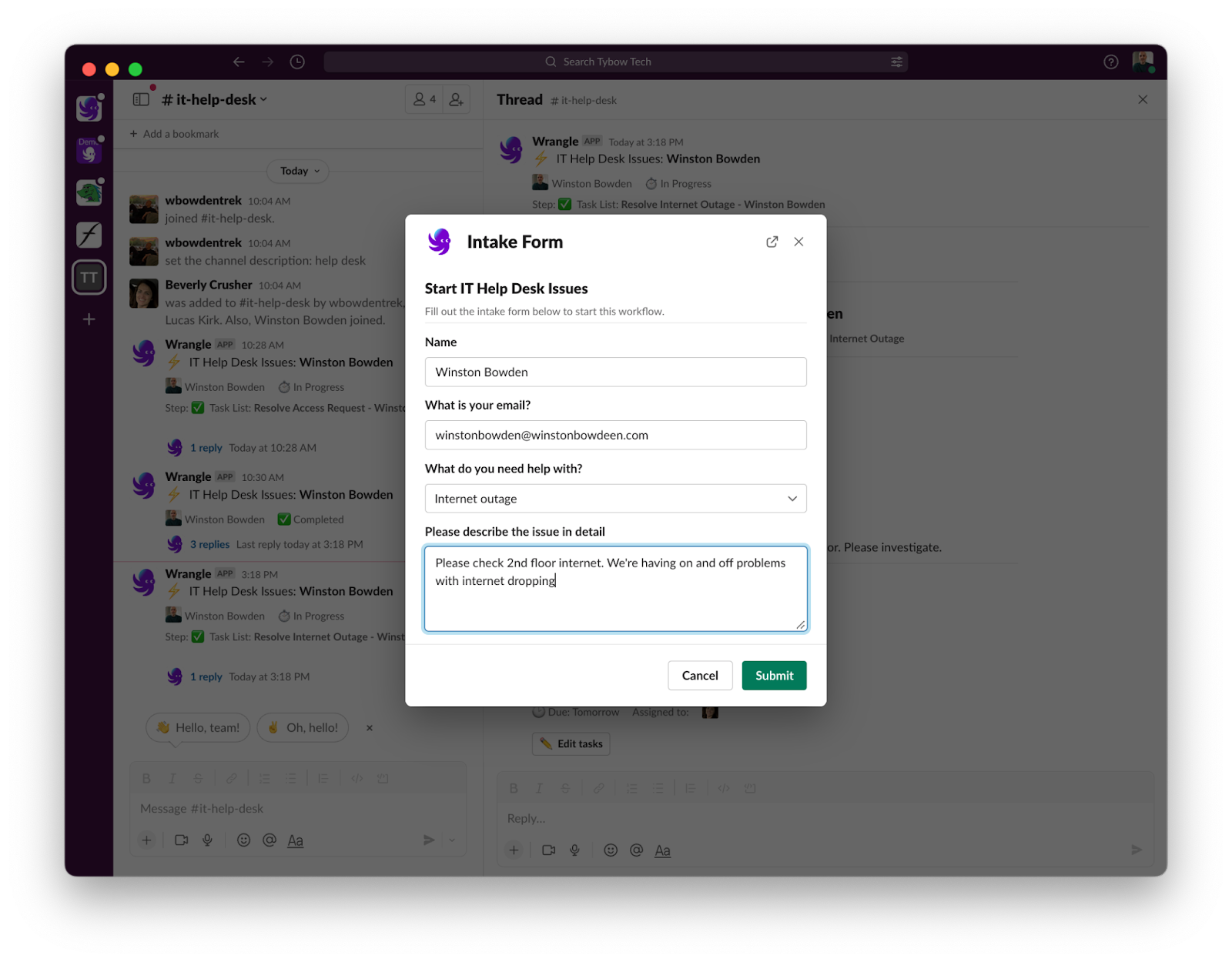
Our employee experiencing the outage can access the workflow by going to the Wrangle app in Slack or typing /wrangle anywhere in his Slack workspace. He chooses the “IT Help Desk Issues” workflow and reports the internet outage. When he submits, the issue will create a ticket with a task list in the Slack channel we selected when we designed our workflow. In this case, it’s posting to the IT help desk channel.
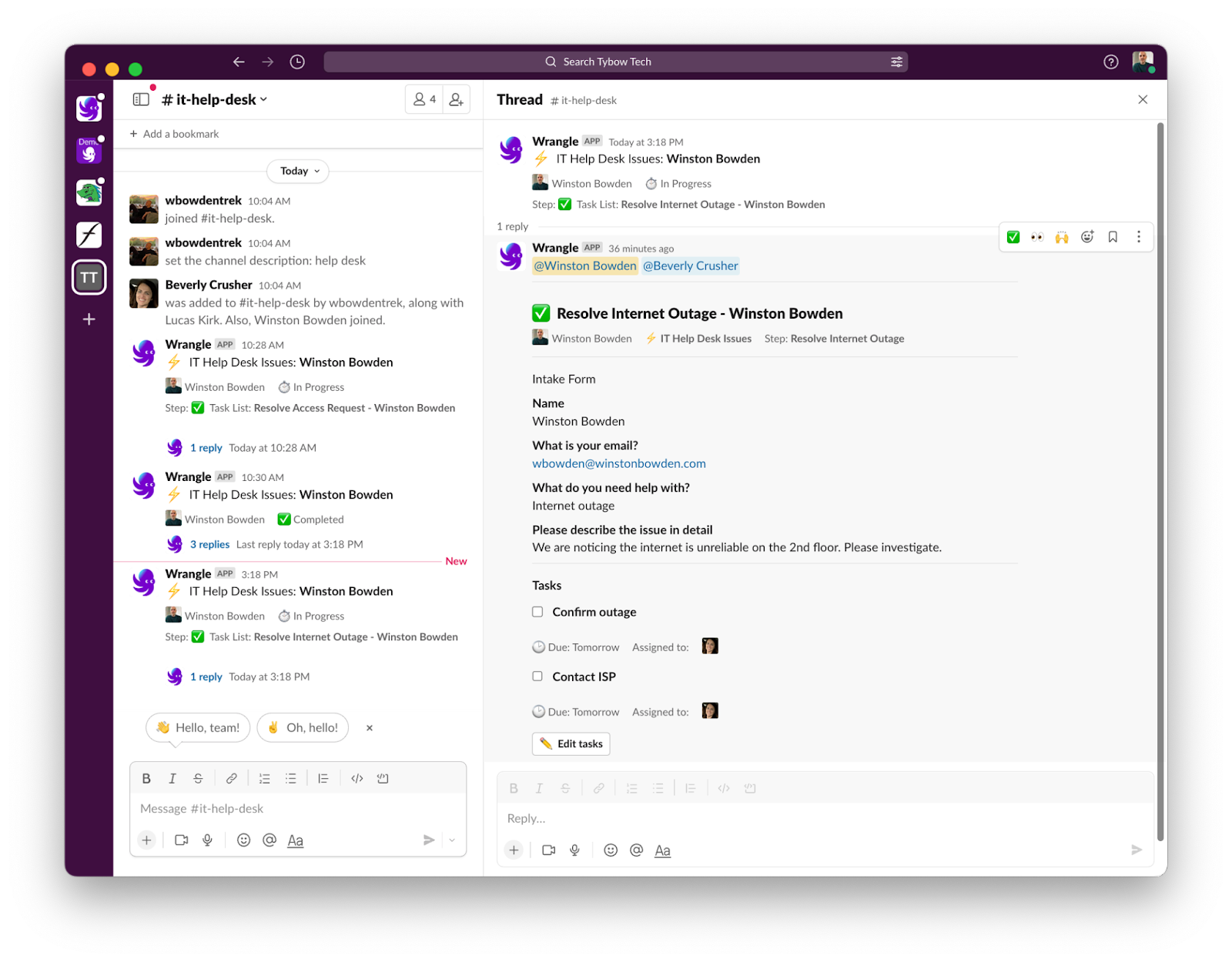
As soon as our employee hits submit, Wrangle automatically creates a ticket with a task list for the assignee, which in this case is Beverly. Wrangle posts the task list in the it-help-desk Slack channel as designed, giving everyone in the channel a heads up.
Beverly can manage this request in Slack if she wishes, but she can also log in to the Wrangle web application to see all of her requests in one place and manage each instance as a ticket with the associated task list. She can even take action on the requests in the web application. When she completes a task, she can hit the check mark. The completed tasks will also be checked off in Slack and ping the help desk Slack channel. And, of course, Wrangle will alert the employee who reported the issue, letting them know that the ticket has been assigned. The workflow will also let them know when the ticket has been completed, and the internet outage has been resolved. Wrangle’s reporting allows you to look at the volume of inbound requests and categorize them by type helping you understand your funnel. This is something you can’t achieve using the previous Slack methodologies we outlined.
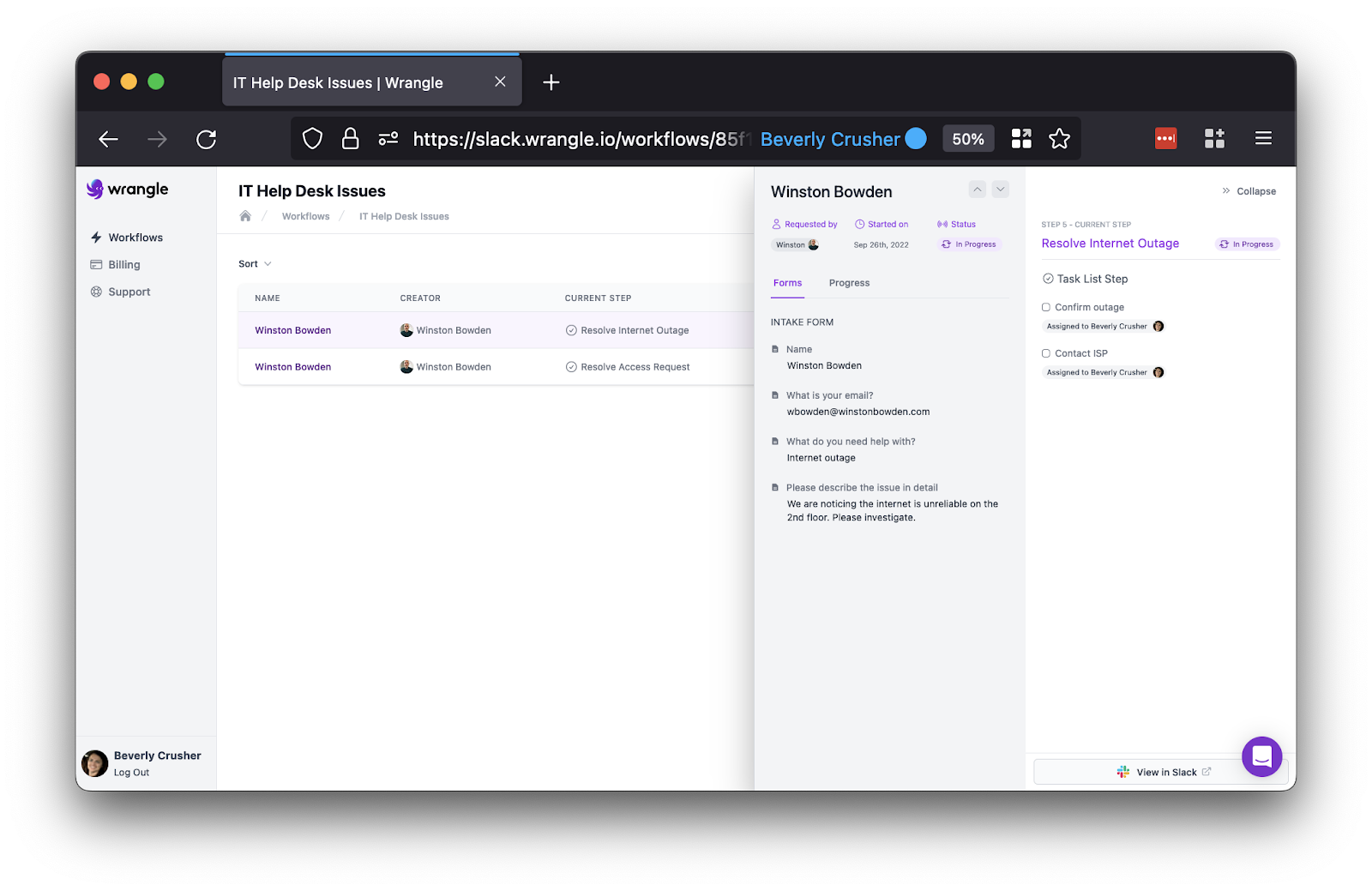
Start managing tasks in Slack the easy way
As you can see, there are lots of ways you can efficiently manage your tasks in Slack. Whether you start simple with Slack alone or level up with a tool like Wrangle, you can dramatically improve your team's efficiency.
Wrangle workflows are available for all types of approvals, requests, and tasks. In the above example, we focused on an IT help desk, but you can use Wrangle to manage processes for budget approvals, creative reviews, expense management, document approval, bug reports, and so much more.
You can try Wrangle for free, or schedule a demo for a complete tour of the application.
This post was written by Siddhant Varma. Siddhant is a full stack JavaScript developer with expertise in frontend engineering. He’s worked with scaling multiple startups in India and has experience building products in the Ed-Tech and healthcare industries. Siddhant has a passion for teaching and a knack for writing. He's also taught programming to many graduates, helping them become better future developers.

- Try Wrangle free for 14 days
- Turn messages into trackable tickets
- Build a scalable help desk



Turn Slack into a productivity powerhouse with Wrangle
Create a scalable helpdesk in Slack. Automatically turn messages into trackable tickets and provide faster, more transparent service to your colleagues and customers with Wrangle — Try it free!






